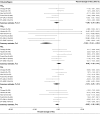Air Pollution and Lung Function in Minority Youth with Asthma in the GALA II (Genes-Environments and Admixture in Latino Americans) and SAGE II (Study of African Americans, Asthma, Genes, and Environments) Studies
- PMID: 26734713
- PMCID: PMC4910900
- DOI: 10.1164/rccm.201508-1706OC
Air Pollution and Lung Function in Minority Youth with Asthma in the GALA II (Genes-Environments and Admixture in Latino Americans) and SAGE II (Study of African Americans, Asthma, Genes, and Environments) Studies
Abstract
Rationale: Adverse effects of exposures to ambient air pollution on lung function are well documented, but evidence in racial/ethnic minority children is lacking.
Objectives: To assess the relationship between air pollution and lung function in minority children with asthma and possible modification by global genetic ancestry.
Methods: The study population consisted of 1,449 Latino and 519 African American children with asthma from five different geographical regions in the mainland United States and Puerto Rico. We examined five pollutants (particulate matter ≤10 μm and ≤2.5 μm in diameter, ozone, nitrogen dioxide, and sulfur dioxide), derived from participant residential history and ambient air monitoring data, and assessed over several time windows. We fit generalized additive models for associations between pollutant exposures and lung function parameters and tested for interaction terms between exposures and genetic ancestry.
Measurements and main results: A 5 μg/m(3) increase in average lifetime particulate matter less than or equal to 2.5 μm in diameter exposure was associated with a 7.7% decrease in FEV1 (95% confidence interval = -11.8 to -3.5%) in the overall study population. Global genetic ancestry did not appear to significantly modify these associations, but percent African ancestry was a significant predictor of lung function.
Conclusions: Early-life particulate exposures were associated with reduced lung function in Latino and African American children with asthma. This is the first study to report an association between exposure to particulates and reduced lung function in minority children in which racial/ethnic status was measured by ancestry-informative markers.
Keywords: air pollution; ancestry; children; lung function; minority.
Figures



Comment in
-
Nature versus Nurture: Does Genetic Ancestry Alter the Effect of Air Pollution in Children with Asthma?Am J Respir Crit Care Med. 2016 Jun 1;193(11):1196-8. doi: 10.1164/rccm.201601-0138ED. Am J Respir Crit Care Med. 2016. PMID: 27248587 Free PMC article. No abstract available.
References
MeSH terms
Substances
Grants and funding
- R01 ES015794/ES/NIEHS NIH HHS/United States
- P30 ES007048/ES/NIEHS NIH HHS/United States
- KL2 TR000143/TR/NCATS NIH HHS/United States
- K12 HL119997/HL/NHLBI NIH HHS/United States
- U19 AI077439/AI/NIAID NIH HHS/United States
- R01 HL104608/HL/NHLBI NIH HHS/United States
- U01 HL126493/HL/NHLBI NIH HHS/United States
- P60 MD006902/MD/NIMHD NIH HHS/United States
- K23 HL125551/HL/NHLBI NIH HHS/United States
- R01 HL088133/HL/NHLBI NIH HHS/United States
- T32 GM007175/GM/NIGMS NIH HHS/United States
- K23 HL111636/HL/NHLBI NIH HHS/United States
- R25 CA113710/CA/NCI NIH HHS/United States
- K23 HL004464/HL/NHLBI NIH HHS/United States
- M01 RR000188/RR/NCRR NIH HHS/United States
- R01 HL078885/HL/NHLBI NIH HHS/United States
- K23 HL093023/HL/NHLBI NIH HHS/United States
- T32 GM007546/GM/NIGMS NIH HHS/United States
- R21 ES024844/ES/NIEHS NIH HHS/United States
- R01 ES025786/ES/NIEHS NIH HHS/United States
LinkOut - more resources
Full Text Sources
Other Literature Sources
Medical

